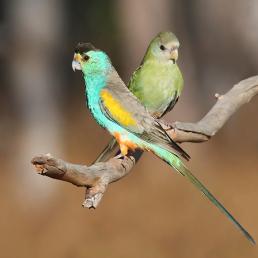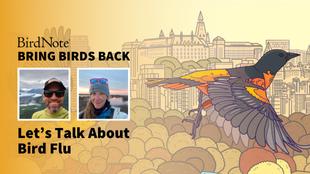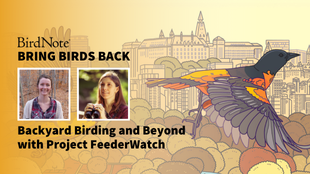

Join BirdNote tomorrow, November 30th!
Illustrator David Sibley and actor H. Jon Benjamin will face off in the bird illustration battle of the century during BirdNote's Year-end Celebration and Auction!

Since Tenijah Hamilton began birding, a lot of questions have come up about why birds do some of the strange things that they do. Writer and biologist Wenfei Tong joins Tenijah to answer some burning questions about what’s going on with our bird friends – questions about different parenting styles to reasons why birds were more noticeable during the pandemic. And of course, the question plaguing all of us: are birds tiny dinosaurs?
Tenijah Hamilton: From BirdNote, this is Bring Birds Back. I'm Tenijah Hamilton.
[Cheerful, joyful music starts with dawn chorus in the background]
A lot of bird-nerds have a similar origin story: they had an experience where maybe they saw a species that just captivated them, or a friend started pointing out details about the birds around them. And then with that little spark, they start to notice birds everywhere. Hearing them on a walk, really noticing them when looking out a window. My story was like this, with my friend Robin teaching me about the birds in our city on walks during the early days of the pandemic. And what really got me? It’s that birds—they’re just like us! They sing, squawk and squabble…and I sing…in the shower. They’re fiercely protective over their families, as am I, but understand the importance of a good shove out the nest. Bird behavior is just fascinating.
For so many people, this part, noticing the surprising and strange things birds are up to, is what gets them hooked. So today, we’re looking at some especially weird bird behaviors — selfishly, this was a great chance to get some answers to my own questions. But also to help you, dear listener, fall further down the rabbit hole — or to share with your friends to help give them a little push towards caring for birds.
The Bring Birds Back team and I gathered up some questions about bird behavior ranging from different parenting styles to how the pandemic influenced birds, and I called up a friend of BirdNote…
[Infant screams]
Wenfei Tong: Gosh, sorry, is my son screaming a lot?
Tenijah Hamilton: No worries, kids are kids.
Wenfei Tong: OK, Um…
Tenijah Hamilton: Biologist and writer Wenfei Tong is the author of the books Bird Love and Understanding Bird Behavior. She just recently joined the Cornell Lab of Ornithology — who, by the way, has been a sponsor of BirdNote. (What can we say, they’ve got great taste.) And she’s also mom to her son, Martin, named after the family of birds — which is just adorable.
[Purple martin calls]
Go listen to our episode from last season about Purple Martins if you want to fall in love with those birds too.
Today we’ve got a real wide-ranging slate of questions about birds, and I am so excited to dig in. But to start us off — Wenfei, can you tell me about you and how you got here?
Wenfei Tong: Oh my, in terms of my history with birds?
Tenijah Hamilton: Oh, in terms of anything. We are curious. We are a curious audience.
Wenfei Tong: Well, my accent always puzzles people, so I'll start there. I come from Singapore. I grew up in a very urban environment and I somehow had some predisposition to really going after animals and nature from very early on. So my mother has a story about how she was trying to teach me to speak as a baby. And one of the first words to come out of my mouth was Baba, which means father in Chinese. So my father was, you know, kicking his heels up in delight. And then it turns out I was just pointing to a sheep on the wall.
[Baby sheep bleating]
And I had all the animal sounds down. So baba was just my word for sheep. But yeah, this started early.
[Baby sheep short bleat]
And then growing up in a very urban place. That all grew into a love of birds and bird watching because unlike a lot of other animals, birds are there in almost any environment, and, uh, there was a bird that's called a Yellow-vented Bulbul that's very common in Singapore.
[Yellow-vented Bulbul singing sweetly]
It's something like the equivalent of the American Robin here in New York. And I found this bird nesting right outside my bathroom window when I was about 12 and just suddenly thought, wow, that's really, really cool. That so much intimate natural history is happening right outside my window. And this is not something I just had to read about in books or see on TV, it's, it's right there.
[Yellow-vented Bulbul chirping softly]
So that made me want to know what bird it was. And that introduced me to some wonderful mentors within Singapore.
And I was always one of those dweeby, slightly out of place children. I'm an only child. And so I got on much better with people my parents' age than people my own age. And I didn't have a lot of interest in common with some of the other people at school. So, you know, most of the kids in Singapore would want to hang out in malls or go to movies or go bowling or something after school. And all I wanted to do was find some birds or find some nature. And so getting introduced to the nature society in Singapore and having these adult mentors show me what it's like to just love nature and be out watching birds all the time was a wonderful introduction to where I am now.
Tenijah Hamilton: And that was likewise, a wonderful introduction to you. And I don't know if I've heard as entertaining a story as this whole baba situation. I love that you, you came out the gate and you were like, let me humble you a little bit. Talking about this sheep.
Wenfei Tong: I know, my poor father.
Tenijah Hamilton: I think that's lovely.And I know that you've been across the world and you've done field research everywhere from Zambia to Montana. So, I'm curious about this, and this is kind of a big question, but is there something about birds that's like, if, no matter if you're watching in Zambia or if you're watching in Montana, this is gonna be the truth about them.
[Light, atmospheric music begins]
Wenfei Tong: Well, I suppose all the things that draw a lot of people to birds would be part of those truths. That most of them fly. And we love looking at them and admiring the way they master the air. And that's a medium we can't compete with, even though we've got planes and rockets and things now. I suppose something that is universal is they're this very accessible yet slightly different organism that's often very beautiful, but it's also a living thing just as we are. And every bird has its own distinct evolutionary history, but they've all evolved for just as long as we have. And they share a lot of the same behaviors and motivations ultimately, through the evolutionary history that we do. So I guess the kind of commonalities that draw all birds together, I would say, tend to draw a lot of living things, including humans, together, too.
Tenijah Hamilton: Yeah. I feel, as somebody who is still getting to know birds, it's really impactful for me, as I learn about them, to think about them in a scope of like, they are also these fully independent, fully alive beings with their, you know, their own social systems and their own ways of living. And it just makes it more exciting. Um, so I really appreciate that perspective.
Wenfei Tong: Oh, I'm so glad. And I should say that's informed from a lot of inspiring books that I read growing up. One of my favorite authors was Gerald Durrell, who was one of the pioneers of zoos for conservation. He had this ability to describe animals as though they were people and people as though they were animals, interchangeably. And I think that, coupled with growing up as an only child and getting a lot of my own sort of mentorship from my dog raised in me this attitude that all the animals around me are just as much people as the humans around me. And I, I've never seen much distinction between the two.
[Light, atmospheric music ends]
Tenijah Hamilton: That is a really cool philosophy. And I mean, it seems like an underpinning of a lot of your work is a strong desire for us as humans, not just to know birds, but to identify with them. Why is that the case?
Wenfei Tong: Yeah. So you really can't get conservation done nowadays without a lot of cooperation from all the people who depend on the particular landscape or area that you're trying to conserve. And so to get that kind of buy-in — to motivate people to want to care about the natural world, I think it's just important to find ways that you get the natural world to really resonate with people at a deep level. And I just think birds are such a good group for doing that because they have so many entertaining behaviors that we can really relate to. And they're also just very captivating and beautiful and charismatic all on their own. So through identifying with them, we learn to care about them. And then through caring about them, people will want to protect the birds and the places they live.
Tenijah Hamilton: I love that. So now that we know a bit more about you, I want to shift gears to some questions about bird parenting. You write about this in your book Bird Love, and this is fascinating to me.
Wenfei Tong: Oh, good.
Tenijah Hamilton: Because I, speaking as a human, which I guess is the only perspective here that I could speak from. We get such a deluge of, you know: here's what the perfect parents are, you know, what to expect when you're expecting. And all of these different things. And I am really jumping out of my seat with joy, thinking that I want to know how this all applies to the bird world. So I know you did a lot of research on different parenting approaches for birds. What are some styles that stood out to you the most?
[Jazzy, playful music starts]
Wenfei Tong: Oh, we ll obviously as a female and as a feminist, what biologists call sex role reversals are front and center as my favorite chapter in the whole book. It's what I secretly called the women's lib chapter, or that was my personal shorthand. But that's all about examples where males are the primary caregivers and often also the less showy sex and the less ardent sex when it comes to courtship. And females are often bigger in those species and they go around the multiple males that they're paired with and lay the eggs for them and then leave the males to do all the rest of their childcare. So those kinds of species are my favorite. They're a minority among birds, but it's in quite different groups, evolutionarily. Meaning that we know it's evolved multiple times. It's not that all the birds from a single evolutionary ancestor have this behavior, right? So for instance, it's quite common among shorebirds so birds like, um, the Spotted Sandpiper are well known for this. But there's also another shorebird relative called the jacana, which is also called lily trotter because it's got extremely long toes that allow it to walk on lily pads without sinking. They're also called Jesus birds. Anyway, the jacanas are one group where males care for the kids and females don't really care for the kids.
In other groups of shorebirds, it's more flexible and more fluid. So maybe more like humans in a sense, where in some populations you've got both parents caring. In some populations, you've got more females doing most of the caring. And in other populations, you've got primarily males. And I hate to say it, but it comes down to who can re-pair fastest. So it's kind of a mating market strategy in those cases. If the guys can get another partner really quickly, then there's less incentive for them to hang out and take care of the children because they know that they'll find another option fast. And in terms of passing on your genes, it makes a lot of sense to just go for another mating and another female. But if it's going to take you a really long time to find another mate, then maybe you should just be the one to hang out and be left holding the babies.
Tenijah Hamilton: Take care of house and home.
[Jazzy, playful music fades out]
Wenfei Tong: Right. Because you don't have another option that easily. Um, I was just going through the book when I was trying to refresh some of this stuff before the interview, and I remembered this caption, where it says something like: in Herring Gulls, divorce is often triggered by a failed nesting attempt. And that always makes me laugh because I had a failed nesting attempt with a divorce to follow. And so I guess that brand of dark humor is something that runs through my books.
Tenijah Hamilton: Yeah. Yeah, I absolutely understand that. And I'm— can you elaborate a little more. So—
Wenfei Tong: You mean elaborate on my personal experience or elaborate on the use of divorce?
Tenijah Hamilton: Oh, no sorry— For the bird.
Wenfei Tong: No worries.
Tenijah Hamilton: For the birds. So if we're talking about divorce — because these are really interesting ways that we don't tend to think about birds, right?
Wenfei Tong: Yeah. And interestingly, words like divorce are in the animal behavior scientific literature. So people will talk about divorce rates in different species. But other words that we might think of as quite anthropomorphic are not in the literature and it gets very — people will get very exercised about which ones are or are not too anthropomorphic, which I think of as a bit of a red herring. Because at some level, we're all kind of going through these behaviors. So I don't know what you want to call it, but they're probably quite similar between birds and humans or between different species of birds.
Tenijah Hamilton: Yeah, that kind of goes back to your, one of your initial points, that we're not that different. And that's why it's important to not just know, but to identify.
Wenfei Tong: Right.
Tenijah Hamilton: So another model or approach that I'm really interested in is this cooperative breeding model. And I know that woodpeckers — or at least Acorn Woodpeckers— they use cooperative breeding. And it's where a sibling helps take care of other chicks or a community takes care of all chicks. So I am happy to apply this to my life, cause I am the oldest of five.
Wenfei Tong: Oh yes.
Tenijah Hamilton: Um, I have four younger siblings and I was like, I was a cooperative breeding model bird. I was a woodpecker!
Wenfei Tong: You were, you were! Absolutely, yeah. They're a really cool example because they're, again— it's a situation where the species is flexible. So some populations of Acorn Woodpeckers are cooperative breeders and others are just the more nuclear family structure without the whole: let's share a nest hole. But to your point about the different sorts of cooperative breeders, one of my favorite analogies for one of the variants, which is where the older siblings or older relatives often stay back to take care of the younger kids is what's also known as delayed dispersal, which gets at the housing crisis for a lot of millennials in developed countries. So the idea there is that, in some way, it's very, very hard for the newly independent birds to find their own place to nest and settle down. And so it's better for them to kind of hang out with their parents and take care of the younger siblings than to try and go it alone when there's basically no territories available for them to occupy. And so if they were going to try and make it on their own, they'd basically be floaters and be bullied by everyone and not be able to acquire their own territory. Which is a bit like, you know, if you've fledged, the human nest and you've graduated from college or whatever, and you should be able to get a job and then find a house and settle down and find a partner and start producing kids. But if all the houses are just way too expensive for you to even buy, you end up just hanging out with your parents at home. And, in many birds, the parents are not going to just allow you to hang out at home. They're going to say, well, do something, please do something useful to earn your keep.
Tenijah Hamilton: You are like reading my life story. I mean, this whole conversation is really reframing how I'm thinking about birds, because you are saying that we should identify these parallels and I'm like, yeah, this is real parallelly, for lack of a better word. Like I see this for sure. This dynamic and how that makes a lot of sense.
Wenfei Tong: Uh huh. And I just love knowing some of that, because now whenever I look at a bird, I'm not just thinking, oh, that's a Acorn Woodpecker, or that's a Northern Flicker or whatever. If I’m if I know a bit about the birds, it's almost like seeing a friend or something and then thinking, oh, I wonder what they're off to do right now today.
If it's breeding season, then maybe they're off helping feed someone else's chicks or something. I should mention though, that the other type of cooperative breeding is more what the Acorn Woodpeckers practice, where no one's really taking care of their younger siblings for a dominant pair of parents. That's more like what wolves do or what some other birds do. In the Acorn Woodpecker model, it's a case where you've got multiple breeding pairs and they collectively guard and maintain a nest hole and they all feed each other's chicks. And the different females will take turns incubating the eggs. So that's a more, like hippie, communal style of cooperative breeding, and it does have its dark side. They both have their dark sides. But the communal model has its dark side in the sense that different females, because they often aren't related to each other, will do their best to get an unfair advantage in a sense by destroying the eggs of other females so that they have more kids in the communal pool that everyone's helping care for. So that type of cooperative breeding can get a little ugly.
Tenijah Hamilton: But it's really good to know, kind of, both sides of that situation.
Wenfei Tong: Oh yes, absolutely.
[Fun bossa nova music starts]
Tenijah Hamilton: Alright, we're going to take a quick break, but when we come back we're going into some of the weirdest bird behaviors out there. Trust me, you don't want to miss out.
[Fun bossa nova music fades]
Tenijah Hamilton: And we're back. I have kind of a grab-bag of questions about weird bird behaviors, from dealing with pests to singing in the city. This first one is from the wider BirdNote team. So, why do some birds like woodpeckers or Brown Creepers move up a tree trunk and others like nuthatches and black and white warblers go downward and upside down.
Wenfei Tong: Um, so I don't have a good answer for that. The general answer you hear, if you Google or something is probably the slightly hand wavy explanation of maybe it gives them a different perspective and therefore gives them an edge in terms of finding things that are hiding under the bark, which is what a lot of these birds are after, or, or just on the surface of the tree trunk. A broader view of that is this idea that almost all the species we see at any one time in evolution have carved out their little ecological niche, their little space in which they're the best at doing something that enables them to outcompete everyone else in this very crowded matrix of species. And so broken down for just a tree trunk, I guess you could say some birds go up and some birds go down and that allows them both to coexist at the same tree trunk level. Uh, but there isn't very good evidence for this. So that's why I said it's a bit of a hand waving explanation.
Tenijah Hamilton: OK, that makes sense — birds evolve to fill niches and share space with each other.
So another question I have, um, thinking about the start of COVID. And I remember that a lot of people, myself included, took more notice of birds and it sounded almost like the birds were louder, or we can hear their birdsong more clearly. And I'm wondering if you can kind of pinpoint what's happening there. Is it just because there was less traffic, so we heard them more? Were they actually singing louder? I'm curious to hear your thoughts.
Wenfei Tong: Yeah, it's a bit of all of the above. And it's, it's so cool that you ask this in the sense that there's been a, almost a cottage industry of papers studying the effects of lockdown and what people have now termed the anthro-pause, on, all of nature. So how much have our carbon emissions changed, how much are birds behaving differently? And so, the first paper to really study this at a very impressive level was a paper out of California where the scientists were studying , I think it was White-crowned Sparrows, in the San Francisco bay area. And they noticed it wasn't just that the birds were changing how loudly they were singing or that more people were paying attention. But actually, in the bay area, there's so much traffic most of the time that the birds have had to shift their frequency. So how high pitched or low pitched their songs are has to kind of bracket the traffic noise, because otherwise they're in direct competition with the traffic noise and they'd lose and they wouldn't get as many mates or whatever.
So, what the relative quiet of COVID lockdown did was allow the birds to retap into their natural range. You know, it'd be like going to an orchestra, an opera singer or something and saying, oh, you can only hit the very highest notes in the song and everything else has to be erased from your repertoire.
[Excerpt from Carmen over sounds of traffic in Times Square]
And that would just give you a very impoverished concert or in the case of the birds, possibly a language or way of communicating, right? Uh, so COVID didn't just allow us to hear the birds better. It allowed them a much wider range of communication through, through a wider range of sounds that they could afford to make and actually worth making.
Tenijah Hamilton: Was there essentially a bird meeting and they were like, the time is now let's make our noise. Let's change our frequency. Like, let's take advantage of this moment because if so, brilliant. Ten out of ten.
Wenfei Tong: Oh, yeah, I wish there were. I mean, probably not with the sparrows, just because they're not that communal. So there wouldn't be much chance of them meeting. But, you know, probably it's more of a trial and error thing where someone just thought, oh, I'll give it a try singing all the notes in my entire range. And hey, he got a bunch more females interested than he used to. And so he just carried on doing that. And then his neighbor and competitor realized that he should start doing that too. Or he was going to lose out and probably it spread that way would be my guess. So a combination of trial and error and watching what your neighbor does.
But yeah, there's also been cool studies in general, showing that there are more birds flocking into places that were traditionally very crowded with people and people's activities. So cities, airports, major roads. There've been a lot more birds sighted for most species, at least in North America. So it's probably the same for other places where we don't have as much data, during the lockdown, than there were birds sighted and recorded outside lockdown conditions. And this is controlled for the sudden rise in birding in general. So it's not, it's not just a case of, hey, there were more people paying attention and more people using eBird, therefore we ended up with more birds sighted. It's controlling for that.
So really there were more birds in places like major roads and airports, than there were without lockdown.
I should say that there's been a few studies that have looked at whether or not this little anthro-pause of lockdown really benefited birds in a substantial way, as opposed to maybe some temporary, oh, we saw more birds because more birds hung out in the cities when there was less noise.
And the answer there is potentially not much. So I didn't want it to sound like, oh, everyone will live happily ever after because there's been this great pause in carbon emissions and noise pollution. If you look at things like how many birds had babies during lockdown and after lockdown, and did lockdown really make a difference, the answer is not so much.
Tenijah Hamilton: Alright, it’s definitely easy to see those changes and think “this could fix everything!” Good to set expectations there.
So, I have just one more question.
[Groovy flute and bongos music begins]
This question came from me because in my heart of hearts, I'm a child. I hear often that people say birds are like tiny dinosaurs. How true is that? Are birds tiny dinosaurs?
Wenfei Tong: Of course, totally true. The only surviving ones.
Tenijah Hamilton: Yes. Please tell us more. Um, how much of their behavior is dinosaur-like?
Wenfei Tong: Oh gosh. So much. And, um, some of this is primed by perspective, right? Because since I already know that I think birds are dinosaurs, um, I see it all the time. But one of the coolest examples I think is the way young birds when they've just fledged the nest, and this might resonate with people who've just found what looks like a hapless baby bird on the ground who's not very good at flying or can't fly at all. And you think the parents abandoned it. This is a very common phase of life for a lot of perching birds. And it's also the stage where they're very vulnerable to cats. But what they do to get around and get back near the nest is they just clamber about. And that seems to be quite dinosaur-like, or quite early bird-like in the sense that the earliest birds probably didn't fly and they would still have wings and they would still get around by clambering about on low branches. And one of the hypotheses for the kind of evolution of feathers is that birds first used that as a sort of balancing tool to help when they were trying to move around in the way young birds do now, but not necessarily as a flight tool
Then there are other behaviors that go way back to the dinosaurs. So since we were talking about parental care, like, sitting on eggs is something that a lot of dinosaurs did. And there's been more and more evidence, especially from China, that a lot of different dinosaurs cared for the eggs by sitting on them and then cared for their chicks, just because you see the fossils, you see the skeletons of the fossils, where you've got adults next to tiny ones. And then I suppose just when birds are being very aggressive, especially birds in the chicken group. So, you know, I've been attacked by wild turkeys and grouse who are feeling very territorial and want to come and sit on my knee and show me how important and fierce they are. And they do remind me a bit of the velociraptor scene in Jurassic park.
[Clip from Jurassic Park - Velociraptor hisses]
When you're running from a enraged Tom Turkey. That's definitely something that pops to mind.
[Clip from Jurassic Park - Velociraptor growls]
[Outro music fades in]
Tenijah Hamilton: Wenfei, this has been such a blast. Thanks for joining me today for Bring Birds Back!
Wenfei Tong: Thank you. Thank you so much for the opportunity.
Tenijah Hamilton: Wenfei Tong is the author of the books Bird Love and Understanding Bird Behavior. I learned so much from her today — next time I’m in a quieter place, I’m definitely going to listen for the finer detail in birds’ songs. But I have a feeling I’ll need to bring Wenfei back soon to answer more of my burning bird-questions. Stay tuned for that.
Bring Birds Back is produced by Mark Bramhill and me, Tenijah Hamilton. Our production assistant is Sam Johnson. Our fact checker is Conor Gearin. Our content director, and editor this season, is Allison Wilson. Music is by Cosmo Sheldrake, Blue Dot Sessions, and Sam Johnson. Special thanks to Viki Merrick.
About guest Wenfei Tong:
Wenfei is a biologist with a passion for understanding and conserving the natural world. She enjoys sharing her love of birds and biology through her paintings, photography, teaching, and writing. Her two books, Bird Love and How to Read A Bird, use scientific discoveries to show how much humans and birds share, including some of literature’s most basic themes. Her ultimate aim is to inspire as many people as possible to care for and thus protect nature.








